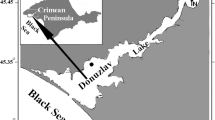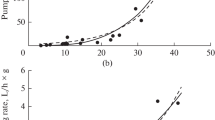Abstract
During laboratory testing it was shown that the presence of the White Sea sponge Halichondria panicea on the shell of the mussel Mytilus edulis negatively affects the functional state of the mollusk as expressed in the increased heart rate recovery time after functional test loads (a 50% water salinity drop for 1 hour). It was found that the degree of this negative influence rises with an increase both in the projective cover of mussel shells by the sponge and in the size/age parameters of mussels.
Similar content being viewed by others
References
Jackson, J.B.C. and Hughes, T.P., Adaptive strategies of coral-reef invertebrates, American Scientist, 1985, vol. 73, pp. 265–274.
Grintsov, V.A. and Poltarukha, O.P., Functional groups of species in the architecture of fouling communities, Okeanol., 2004, vol. 44, pp. 583–588.
Edwards, K. and Stachowicz, J.J., Multivariate trade-offs, succession, and phenological differentiation in a guild of colonial invertebrates, Ecology, 2010, vol. 91, pp. 3146–3152.
Khalaman, V.V., Life strategies of marine sessile organisms as an approach for exploration of structure and succession of fouling communities, Biofouling: Types, Impact and Anti-Fouling, Chan, J. and Wong, Sh., Eds., New York, 2010, pp. 1–33.
Becerro, M.A., Turon, X., and Uriz, M.J., Multiple functions for secondary metabolites in encrusting marine invertebrates, J. Chem. Ecol., 1997, vol. 23, pp. 1527–1547.
Duckworth, A.R. and Battershill, C.N., Population dynamics and chemical ecology of New Zealand Demospongiae Latrunculia sp. nov. and Polymastia croceus (Poecilosclerida: Latrunculiidae: Polymastiidae), New Zealand J. Mar. Fresh. Res., 2001, vol. 35, pp. 935–949.
Erpenbeck, D., Knowlton, A.L., Talbot, S.L., Highsmith, R.C., and van Soest, R.W.M., A molecular comparison of Alaskan and North East Atlantic Halichondria panicea (Pallas 1766) (Porifera: Demospongiae) populations, Boll. Mus. Ist. Biol. Univ. Genova, 2004, vol. 68, pp. 319–325.
Purushottama, G.B., Venkateshvaran, K., Pani Prasad, K., and Nalini, P., Bioactivities of extracts from the marine sponge Halichondria panicea, J. Venom Anim. Toxins Incl. Trop. Dis., 2009, vol. 15, pp. 444–459.
Plotkin, A.S., Railkin, A.I., Gerasimova, E.I., Pimenov, A.Yu., and Sipenkova, T.M., Underwater rock communities in the White Sea sublittoral: the structure and interaction with near-bottom current, Biol. Morya, 2005, vol. 31, no. 6, pp. 398–405.
Khalaman, V.V. and Komendantov, A.Yu., Structure of Halichondria panicea (Porifera: Demospongiae) fouling communities in the White Sea, Ekologiya, 2011, no. 6, pp. 449–458.
Thomassen, S. and Riisgård, H.U., Growth and energetics of the sponge Halichondria panicea, Mar. Ecol. Prog. Ser., 1995, vol. 128, pp. 239–246.
Barthel, D. and Wolfrath, R., Tissue sloughing in the sponge Halichondria panicea a fouling organism prevents being fouled, Oecologia, 1989, vol. 78, pp. 357–360.
Knowlton, A.L. and Highsmith, R.C., Convergence in the space–time continuum: a predator–prey interaction, Mar. Eco.l Prog. Ser., 2000, vol. 197, pp. 285–291.
Khalaman, V.V., Belyaeva, D.V., and Flyachinskaya, L.P., Influence of excretory–secretory products of some fouling animals on the settling and metamorphosis of Styela rustica (Ascidiae) larvae, Biol. Morya, 2008, vol. 34, no. 3, pp. 200–204.
Khalaman, V.V., Flyachinskaya, L.P., and Lezin, P.A., Influence of excretory and secretory products of some fouling animals on the settling of Mytilus edulis L. (Bivalvia: Molluska) Larvae, Zool. Bespozvon., 2009, vol. 6, no. 1, pp. 65–72.
Khalaman, V.V., Korchagina, N.M., and Komendantov, A.Yu., Effect of substances excreted to the environment by individuals of the same and foreign species on the larvae of Halichondria panicea Pallas, 1766 (Porifera: Demospongiae), Biol. Morya, 2014, vol. 40, no. 1, pp. 38–45.
Dyrynda, P.E.J., Modular sessile invertebrates contain larvatoxic allelochemicals, Develop. Compar. Immun., 1983, vol. 7, pp. 621–624.
Althoff, K., Schutt, C., Steffen, R., et al., Evidence for a symbiosis between bacteria of the genus Rhodobacter and the marine sponge Halichondria panicea: harbor also for putatively toxic bacteria? Mar. Biol., 1998, vol. 130, pp. 529–536.
Khalaman, V.V. and Komendantov, A.Yu., Experimental study of the ability of the sponge Halichondria panicea (Porifera: Demospongiae) to compete for a substrate in shallow water fouling communities of the White Sea, Izv. RAN, ser. Biol., 2016, no. 1, pp. 81–87.
Skidchenko, V.S., Vysotskaya, R.U., Krupnova, M.Yu., and Khalaman, V.V., Effect of excretory–secretory products of some White Sea fouling organisms on biochemical parameters of the edible mussel Mytilus edulis L. (Molluska: Bivalvia), Izv. RAN, ser. Biol., 2011, no. 6, pp. 670–683.
Kholodkevich, S.V., Kuznetsova, T.V., Trusevich, V.V., Kurakin, A.S., and Ivanov, A.V., Peculiarities of valve movement and cardiac activity of the bivalve mollusks at various stress actions, Zh. Evol. Biokhim. Fiziol., 2009, vol. 45, no. 4, pp. 432–434.
Kholodkevich, S.V., Sharov, A.N., and Kuznetsova, T.V., Prospects and problems of using bioelectronic systems in monitoring of the state of ecological safety in the water area of the Finnish Gulf, Regional. Ekol., 2015, vol. 37, no. 2, pp. 16–26.
Kholodkevich, S. and Kuznetsova, T.V., In situ measurements of cardiac activity characteristics in indigenous macrobenthic invertebrates for water quality bioindication, Baltic International Symposium (BALTIC), 2014 IEEE/OES, pp. 1–7.
Kuznetsova, T.V., Change of salinity of medium as a functional loading in estimating physiological state of the crayfish Astacus leptodactylus, J. Evol. Biochem. Physiol., 2013, vol. 49(5), pp. 498–502.
Filippov, A.A., Adaptive capacities of adult individual of the White Sea mussel Mytilus edulis (Bivalvia, Mytilidae) for changes in water salinity, Zool. Zh., 2007, vol. 86, pp. 415–420.
Fedotov, V.P., Kholodkevich, S.V., and Strochilo, A.G., A study of contractile activity of the crayfish heart using a new noninvasive method, Zh. Evol. Biokhim. Fiziol., 2000, vol. 36, no. 3, pp. 219–222.
Kholodkevich, S.V., Ivanov, A.V., Kurakin, A.S., Kornienko, E.L., and Fedotov, V.P., Real time biomonitoring of surface water toxicity level at water supply stations, J. Environ. Bioindic., 2008 vol. 3 (1), pp. 23–34.
Kuznetsova, T. and Kholodkevich, S., Comparative assessment of surface water quality through evaluation of physiological state of bioindicator species: searching for new biomarkers, Proc. 2015 4th Mediter. Conf. Embed. Comput., MECO, IEEE conference publications, Budva, Montenegro, 2015, pp. 339–344.
Anokhin, P.K., Ocherki po Fiziologii Funktsionalnykh Sistem (Essays on the Physiology of Functional Systems), Moscow, 1972.
Baevsky, R.M. and Berseneva, A.M., Otsenka adaptatsionnykh vozmozhnostei organizma i Risk Razvitiya Zabolevaniy (Evaluation of Adaptive Capacity of the Organism and Risk of Disease), Moscow, 1997.
Bamber, S.D. and Depledge, M.H., Evaluation of changes in the adaptive physiology of shore crabs (Carcinus maenas) as an indicator of pollution in estuarine environments, Mar. Biol., 1997, vol. 129, pp. 667–672.
Frolov, V.M., Urovni funktsionirovaniya fiziologicheskikh system i metody ikh opredeleniya (Functional Levels of Physiological Systems and Methods of Their Identification), Leningrad, 1972.
Turja, R., Höher, N., Snoeijs, P., Baršienė, J., Butrimavičienė, L., Kuznetsova, T., Kholodkevich, S.V., Devier, M.-H., Budzinski, H., and Lehtonen, K.K., A multibiomarker approach to the assessment of pollution impacts in two Baltic Sea coastal areas in Sweden using caged mussels (Mytilus trossulus), Sci. Total Environ., 2014, vol. 473–474, pp. 398–409.
Lauer, T.E. and Spacie, A., Space as a limiting resource in freshwater systems: competition between zebra mussels (Dreissena polymorpha) and freshwater sponges (Porifera), Hydrobiol., 2004, vol. 517, pp. 137–145.
Lancioni, T. and Gaino, E., Competition between the freshwater sponge Ephydatia fluviatilis and the zebra mussel Dreissena polymorpha in Lake Trasimeno (central Italy), Ital. J. Zool., 2005, vol. 72, pp. 27–32.
Barnes, B.B., Luckenbach, M.W., and Kingsley-Smith, P.R., Oyster reef community interactions: The effect of resident fauna on oyster (Crassostrea spp.) larval recruitment, J. Exp. Mar. Biol. Ecol., 2010, vol. 391, pp. 169–177.
Laudien, J. and Wahl, M., Associational resistance of fouled blue mussels (Mytilus edulis) against starfish (Asterias rubens) predation: relative importance of structural and chemical properties of the epibionts, Helgoland Mar. Res., 2004, vol. 58, pp. 162–167.
Marin, A. and Belluga, M.D.L., Sponge coating decreases predation on the bivalve Arca noae, J. Moll. Stud., 2005, vol. 71, pp. 1–6.
Sukhotin, A.A., Abele, D., and Pörtner, H.-O., Growth, metabolism and lipid peroxidation in Mytilus edulis: age and size effects, Mar. Ecol. Prog. Ser., 2002, vol. 226, pp. 223–234.
Author information
Authors and Affiliations
Corresponding author
Additional information
Original Russian Text © V.V. Khalaman, A.N. Sharov, S.V. Kholodkevich, A.Yu. Komendantov, T.V. Kuznetsova, 2017, published in Zhurnal Evolyutsionnoi Biokhimii i Fiziologii, 2017, Vol. 53, No. 3, pp. 201—208.
Rights and permissions
About this article
Cite this article
Khalaman, V.V., Sharov, A.N., Kholodkevich, S.V. et al. Influence of the White Sea sponge Halichondria panicea (Pallas, 1766) on physiological state of the blue mussel Mytilus edulis (Linnaeus, 1758), as evaluated by heart rate characteristics. J Evol Biochem Phys 53, 225–232 (2017). https://doi.org/10.1134/S0022093017030073
Received:
Published:
Issue Date:
DOI: https://doi.org/10.1134/S0022093017030073




